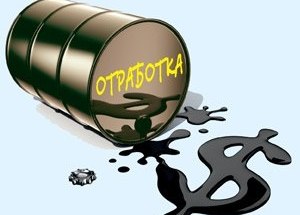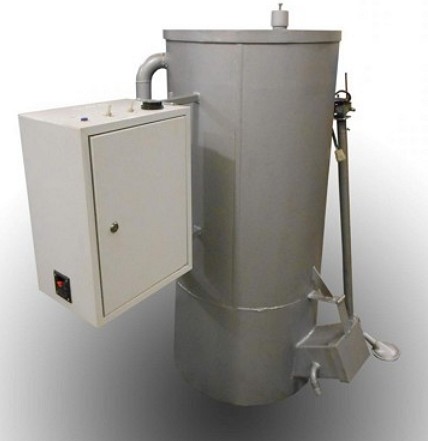The fuel and energy crisis forces us to look for alternative sources of heat. Available fuel for heating a private home can safely be called used oil. But the insidious and unpredictable nature of the "explosive mixture" can easily disrupt plans for an economical heating season. Puhhh! and here from the stove and the private house there can be nothing left. What is the right way to proceed with the construction and arrangement of the heating unit?
Content
Where it is possible to arrange an oven for working: Vasily Alibabaevich warns
The theme of the device and the use of the furnace on waste oil is not new. At present, in connection with the rise in price of energy carriers, this is an actively discussed topic, to which many are showing increased interest. However, working off is considered a dangerous waste, and it will not be possible to acquire it with canister norms.
The kiln on the working (self-burn) is a device with an open flame. In addition, the heated parts of the combustion zone during operation are heated red hot, representing potentially dangerous furnaces. We will make a reservation at once that it is unacceptable to arrange homemade furnaces of this type as a heating device in residential premises.
Therefore, the device of the furnace requires the installation of a non-combustible extension or the creation of fire-fighting conditions for operation. What attracts the primitive design of such furnaces?
Helpful Tips
Chemical composition of waste oil, according to the specifications of GOST 12337-84 Motor oils for diesel engines, is hydrocarbons with a content of 94.2%. Recall that hydrocarbon oils under the influence of oxygen and the appearance of moisture tend to oxidize. And this means that waste oil is an explosive mixture. It is practically impossible to trace the behavior of the mixture in homemade ovens.
Execution - turn the waste into income
furnace operation
The efficiency of the furnace is based on the use of the fuel qualities of waste oil, or rather the fumes that are burned during operation. As a result of the burning of oil vapors, the furnace body made of a thick sheet of metal is heated.
At the design of the furnace, the pipes that surround it play the role of air ducts. Heated air along the pipes takes some of the heat from the working unit and rushes upwards, heating the room.
The furnace device can have the following options:
• convection
• with air heat exchanger
• water boiler with boiler section
Naturally, in order to manufacture the unit with one's own hands, a working drawing of the furnace on the spent fuel is necessary.
features of the furnace design
Structurally homemade spent fuel stoves can be of the following types:
• units from a gas cylinder or sheet steel (round or square)
• supercharged units
• with a drip fuel feed.
The most accessible for hand-made execution is a furnace made of a cylinder and welded steel sheet materials.
For units with supercharged, it is necessary to install a fan that carries out forced air supply.
The unit with a drip fuel feed is complicated for hand-made manufacture. It is recommended to use industrial models that are safe to operate, highly efficient and inexpensive.
Ovens for industrial production
Industrial furnaces are a solid aggregate, based on the principle of operation of which pyrolysis lies. However, unlike wood fuel, used here is used engine oil.
The design of the heater on the waste oil consists of the main working elements:
• combustion chambers and duct cover
• Heater housing with fuel tank
• Fuel supply unit
• the fuel cell controller
• cups of pyrolysis
• the heater cover.
The principle of the boiler is as follows: fuel (working off) enters the preheated pyrolysis bowl, which is located at the bottom of the combustion chamber. When the critical temperature reaches the combustion chamber, gas evolution and its associated combustion begin. The resulting heat rushes up and heats the room. The design of industrial furnaces is thought out to the smallest detail and does not cause dangerous explosions.
But the cost of an industrial-purpose furnace is high and therefore the acquisition of the unit is difficult. Therefore, it is possible to manufacture and install the furnace by hand.
Oven on the waste oil
model of sheet material
The model of the furnace from steel sheets can be made in square or round shape. By welding, two combustion chambers are made, which are then connected together by a tube with holes. A chimney is installed to the upper combustion chamber, and stable legs or a platform are welded to the lower chamber.
The upper part of the chamber can be used for heating food or drying.
Fuel - waste oil is poured into the lower container. To kindle the furnace in a container with working gasoline is added and ignited. After the oil boils, the air damper is covered.
A simple and affordable budget furnace is potentially dangerous, because of the passage of open fire through a pipe with holes.
model from a gas cylinder
A safer model, compared to a pressure cooker, is a furnace made from a gas cylinder in the likeness of a pyrolysis boiler.
This furnace has a solid fireproof design, reinforced with thick walls of the cylinder, and a long period of fuel combustion.
It is recommended to make the air supply to the combustion chamber adjustable, and the fuel supply chamber to be dismantled. An indispensable condition for the installation of a furnace from a gas cylinder is a vertical chimney with a height of up to 4 meters, which ensures reliable traction.
Sequence of works for the device of the furnace on working from a cylinder:
We cut the upper and lower parts of the cylinder. From these halves we make a prefabricated combustion chamber, in the upper part of which an air duct is arranged.
The function of the air duct is to regulate the flow of air and the route of fuel.
In the center of the combustion chamber, a tube with holes is arranged. In the middle of the cylinder, a post-combustion chamber is placed and welded to the blower. After installing the furnace, a chimney is installed.
The principles of the device of the kiln on self-development are presented in the video.




































